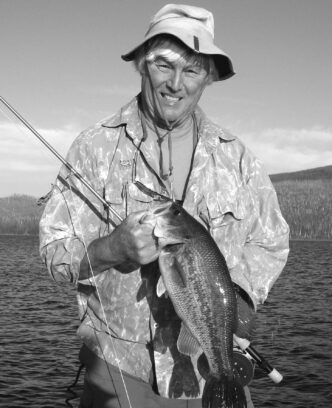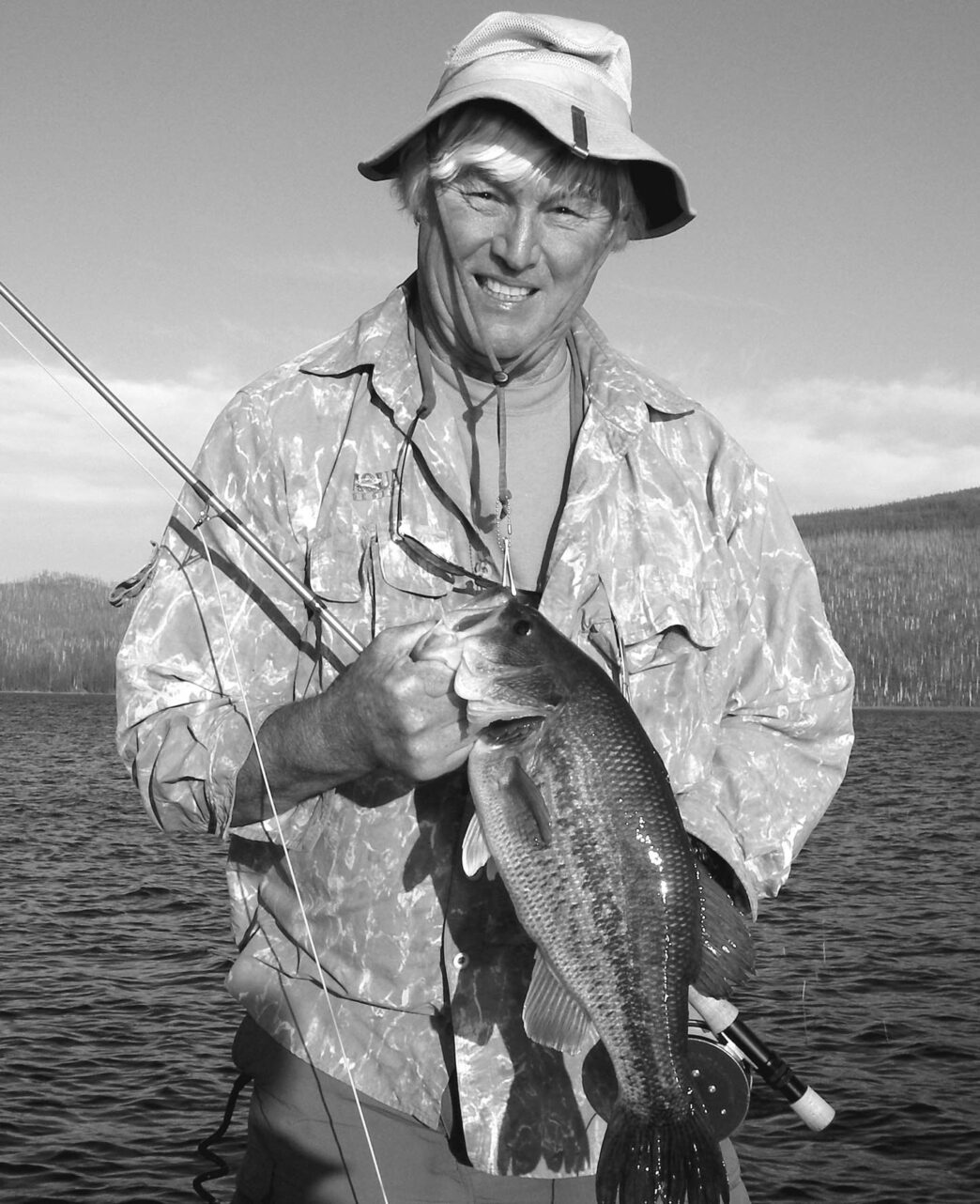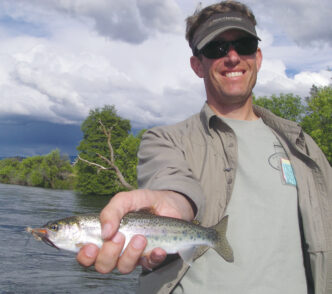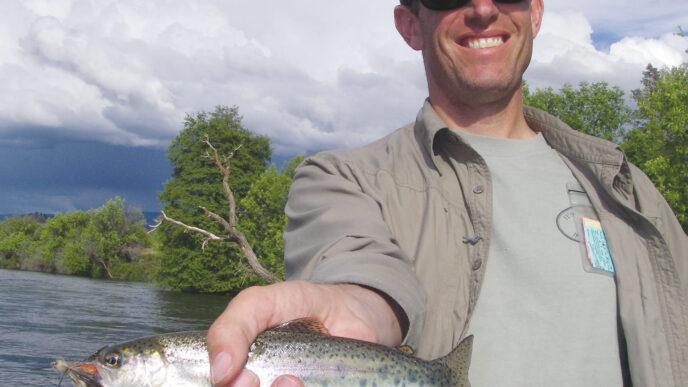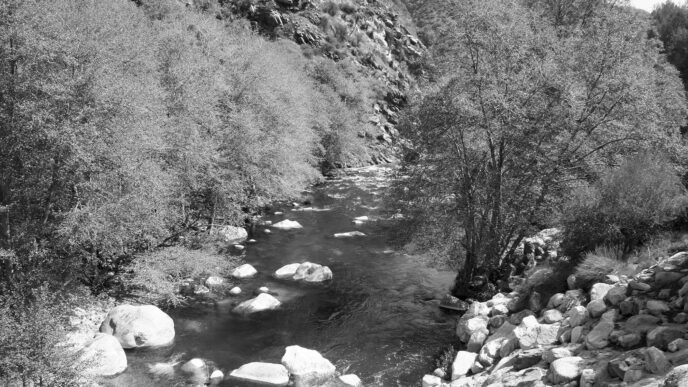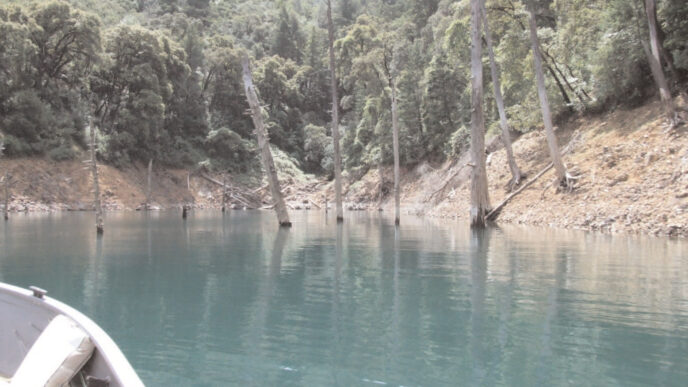The Sacramento–San Joaquin River System, the Delta, and a number California’s rivers and lakes underwent a fundamental transformation after the completion of the transcontinental railroad. First largemouth and smallmouth bass, then spotted bass were introduced into waters throughout the state. Today, like most Californians who hail from families that originally arrived here from somewhere else, they form part of the state’s endowment of resources.
Early on, smallmouths and later largemouths were widely stocked in the Golden State. William A. Dill and Almo J. Cordone’s History and Status of Introduced Fishes in California, 1871–1996 (California Department of Fish and Game, 1997) states that smallmouth bass, Micropterus dolomieu, arrived in California in 1874 from Lake Champlain, Vermont, and were first planted in Northern California’s Alameda and Napa Creeks. Not long afterward, they were introduced to the Spring Valley Water Company’s San Mateo County lakes, and those progeny were distributed widely. Northern largemouths, Micropterus salmoides salmoides, made the journey from Quincy, Illinois, in 1891. Northern spotted bass, Micropterus punctulatus punctulatus, were imported from Ohio in 1933. The last major species to gain a hold was the Florida bass. Micropterus salmoides floridanus was a late arrival, finding new homes in San Diego County lakes in 1959, then in Clear Lake, Lake Amador, and other waters.
Smallmouths spread rapidly in the northern Delta and the Sacramento River system. There was a smallmouth sport fishery there and even a viable commercial fishery. Today, largemouths, including the Florida strain, dominate in the Delta, no doubt because we changed our rivers with dams, dikes, riprap, and water diversions in the name of agriculture, power generation, land reclamation, urban needs, and flood control.
All four species are now widespread and offer a target for flyrodders who are branching out from trout hunting. For a long time, many of us old-timers have been wise to the secret of fly-rod angling for California bass in the spring. We’ve always welcomed the opening day of trout season, because it is a very good time to chase bass when anglers are overcrowding all the cold and high trout streams.
Realistically, fly casters can target and reach only fish that lie in the top 10 feet or so of the water column. Certainly, modern sinking fly lines, such as integrated shooting heads, can and do go deeper, but success with the fly rod at greater depths comes much less frequently. Another factor comes into play, as well: There are few freshwater angling experiences more enthralling than the sight and sound of a large bass blowing up on a bass popper. That’s why we pound our poppers, sliders, hair frogs, rats, and water-snake imitations along shoreline cover and structure, waiting for an explosion and the ensuing tug of war, with its throbbing leaps, head shakes, and bulldoglike runs.
But let’s not go at this blindly, as many anglers new to fly-rod bass fishing are wont to do. There are specific approaches that will help anyone targeting bass with a fly rod be more successful.
Finding Bass within Fly-Rod Range
Fly fishers have a tremendous advantage over conventional-gear anglers in the stealth with which we can approach our target in shallower waters. Our great disadvantage is that our ability to reach fish drops off rapidly as the water gets deeper. Consequently, it makes sense to focus on the kind of water where success is more likely. Start by eliminating steep-sided reservoirs. It’s hard to find bass consistently in a lake 200 to 300 feet deep with a 60-degree slope to its shoreline. There are always exceptions, however. One exception is open water where concentrated forage-fish populations such threadfin shad or pond smelt draw feeding fish. Another is where large numbers of catchable-size trout are planted.
In general, however, look for shallower lakes or lakes with arms and inlets that have cover and near-shore structure. I look for reeds, tules, or trees that overhang the banks. The Delta has plenty of both, plus downed trees and lots of old pilings and pumping stations. Clear Lake epitomizes the type of impoundment that I like. The lake is 60 feet deep at its maximum, and most of it is less than 30 feet deep. There are miles and miles of tules, hundreds of docks and wooden pilings, a few islands, underwater rock outcroppings, and lots of rock-studded shoreline. Don’t go there when 200 bass boats are fishing a tournament, though . . . unless you want to follow the boats and take GPS coordinates.
I like lakes that have constant water levels, even though they are hard to find. Golf course communities are a good bet. Try the back nine at Sunol. Shoreline vegetation develops year-round in lakes that don’t suffer draw-downs, flooded brush abounds, terrestrials are abundant, and shoreline critters take up residence — all good news for populations of bass. Farm ponds both large and small have reachable depths and shoreline cover that holds bass inshore longer than the steep side of reservoirs. The deeper parts there are obvious, and sinking lines can target bass when the water temperatures drive the fish deeper. Golf course lakes and lagoon communities also have rock walls and docks that provide cover for fish. Vineyard ponds, rock quarries, and abandoned gravel pits are favorites because they are not often fished, and most of the year, I can reach the bass with my imitations. Ask questions, knock on doors, stick polite notes in rural mailboxes, and come bearing gifts . . . you may get an invitation.
If I’m fishing deep, steep-sided reservoirs, I immediately head for shallower arms, flats, and the backs of coves. A favorite is a cove that splits toward the back. In such places, look for the side with the sharper drop-off from the peninsula. There may not be flooded brush, but driftwood debris and flooded grasses will offer cover for fish. Hop a weedless popper over logs and sidearm flies under overhanging branches. I won a fly-rod tournament by fishing just the back of coves. Also, older, smaller reservoirs often have rocky dam faces that are worth probing.
In the spring, I look for small seasonal tributaries that dump water into a lake. With the inflow come food, small fish, and predators. You would be amazed at the amount of invertebrates that come down very small inflows.
Weed beds are a bass angler’s dream. They harbor insects such as damselfly and dragonfly nymphs, as well as minnows, tadpoles, and frogs. Fish the edges and openings with poppers or sink an Aggravator there and see what happens. Lily pads and the edges of water hyacinth offer cover to bass for ambushes. Many of the smaller foothill lakes have reed beds. A telltale sign of inshore fish is weaving reeds, tules, or grasses. The movement is caused by aggressive, feeding fish that bump and brush against the plants. Get a weedless popper or dragonfly into the smallest opening, ASAP!
Also, fish mud lines off points. A fierce wind came up one April afternoon at Indian Valley, and mud lines developed off the reservoir’s points. Eight casts into the mud line’s stain took fish as the fly moved into clear water. The bass were lined up, tail to shore, looking for victims. Higher-elevation lakes often get overlooked by flyrodders prospecting for bass because we think of bass as warmwater creatures. Some of these lakes have abundant shoreline vegetation and beds of water lilies, and the bass there fatten on the crawdads and on trout plants. Others are reservoirs with bathtub rings and rock fields filled with crawdads. Look to the riprap of the dam faces. Try a popper and a dropper off the dam face. Do the same with a Woolly Bugger and a trailer. Trout anglers may look with disdain on the bass that you can find in these lakes, but knowledgeable anglers know better.
Many years ago, I had the good fortune to dine with Dee Thomas, who was the first California tournament bass fisherman to win a national tournament. Dee specialized in inshore “tule dipping” with very long rods and a metal jig head with a plastic lizard or worm attached. In the evening’s conversation he said, “There is always someplace where fish will lie inshore all year long.” Seek, and ye shall find.
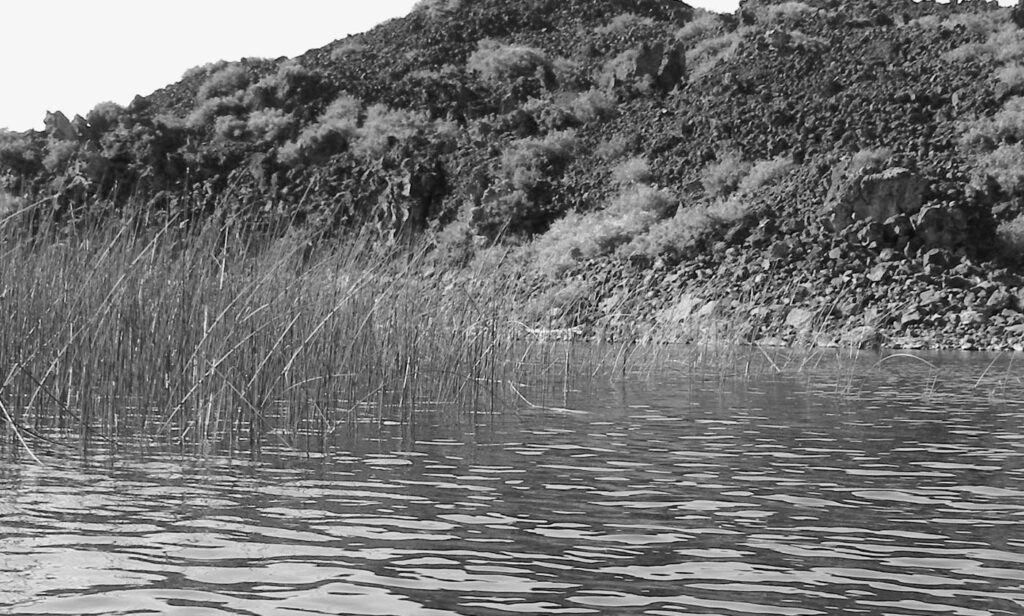
Improving the Odds
Bass may be the most difficult freshwater fish to take consistently on a fly, but there are things you can do to increase the odds that you’ll be successful. A thorough study of their habits and preferences, combined with excellence in casting and presentation, will make you a better angler. Mentor André Puyans was known for his spring creek trout fishing, but few knew he was a master bass angler, too. His lesson: Stop and look for a long time before approaching and spooking the fish in a new area. You can learn a lot in a few minutes. Have a plan as you approach and begin to work an area. In fact, work on a plan even before you go fishing.
I have had the good fortune to fish the Delta and many foothill lakes with a tournament bass fisherman. In late fall, when water levels were at their lowest or on minus Delta tides, he would check out and videotape shoreline topography and equate features with angling success. He had a video library of many Northern California lakes. Following his precedent, I use a digital camera to photograph at low water areas where I have had success. I have many images from a favorite 250-acre golf course lake where I spend a lot of time each spring and early summer.
This lake is a constant-level impoundment from early spring to late fall. It is then drawn down so residents can repair docks and make shoreline improvements, such as rock walls to protect against erosion. During the draw-down, I walk the accessible shoreline with a camera and scope other areas with binoculars. I’m trying to equate success or failure with the exposed underwater features that are revealed when the water level is dropped.
You immediately see why some structure holds fish and other structure does not. One stretch of shoreline always produces larger fish. A low-water examination reveals that the best docks and rock walls are close to drop-offs.
Two years ago, I carefully approached a dock where I had taken a six-pounder a week before. I didn’t throw a bug toward the shoreline for the last hundred feet as I approached the dock, and I skirted the structure quietly, lining up for one good first cast to the shaded corner where the dock butted against a rock wall. I threw a trial cast well away from my target to get my distance. Well, sometimes things just work the way you plan and hope. A huge bass blew up when my size 2 chartreuse Sneaky Pete dropped within six inches of the back corner. You could have heard the crack of the exploding fish from 200 yards away. I was able to hold the largemouth out from the dock, then hang on as it moved down the rock wall and then into deeper water. Ten minutes later, after having my float tube spun 360 degrees many times, I landed a 28-1/2-inch Florida strain largemouth, which is my career all-tackle best.
In January, with the water level drawn down, I went back and photographed the entire west-facing bank and the docks along it. The dock that produced the big fish had a three-foot-deep channel that ran from the bank and paralleled the dock before intersecting farther out with a submerged, winding creek channel. Shoreline development had obliterated the watercourse that had produced the V-shaped ditch, and there wasn’t a clue that it was there at high water. The same shoreline seems always to hold baitfish, and big bass like to feed close to escape or migration routes that lead to the security of deeper water.
Another example: Livermore’s Del Valle Reservoir has a back arm with a horse trough that is underwater in the spring during high water levels. Most anglers never know of or have seen the wooden structure, which appears only when water level drops. We used to take a new member of our fly-fishing club out to the lake and get him to bet on the next cast. We’d then cast a popper toward the grassy bank and retrieve it enticingly over the submerged water trough, which would always hold a bass, if not two. Easy money!
Timing: The Prespawn Period
Bass do not like bright sunlight, and they come into shallow, sunlit water for just one of two reasons. The first is the springtime spawning migration, and the second is in pursuit of food. The timing of both shallow-water incursions is affected by water temperatures and the photoperiod. Warming water and lengthening days stimulate the development of eggs and sperm. Warming water also increases the metabolism of the cold-blooded fish, and as their metabolic rate increases, the bass need more food and become hungry and aggressive. Stored fat from winter supplies the energy for early egg and sperm development, but there is also a need to feed. These factors affect the prespawning, spawning, and postspawning behavior of bass, and understanding these different periods is crucial for angling success.
Initially, warming water and lengthening days coincide with movement from winter depths to staging areas closer to shore. A long underwater shelf or a submerged road bed is ideal for holding staging bass that are actively feeding and waiting for favorable conditions to spawn. First the male bass make inshore forays, looking for suitable nest sites in shallow water, then the females follow. The bass are searching for spawning habitat, as well as mates. Passing cold fronts will move bass back into deeper water, but they will return with warmer, calmer weather. If it is cloudy or windy, the fish tend to roam. This is the only time of year that you want to fish during a full moon, because warming trends and the bright moon bring fish inshore. Not all fish move in at the same time. Some anglers claim that the bigger fish move in early. The prespawn period occurs as early as January in Mexican bass lakes. In the Sierra foothills, I start looking for inshore fish with the first warming trend in March. They will take a top-water fly if conditions are right, but most come to subsurface flies cast on a clear intermediate line, which allows me to cast to cover and work the fly gradually towards deeper water in a slow retrieve. My favorite fly is a large Woolly Bugger tied on a 6X-long straight-eyed hook. The fly has three pairs of variegated rubber legs and is weighted in the front half of the hook shank with turns of lead fuse wire. I stratify two colors in the marabou tail: olive and white or red and black. I’m appealing to the feeding instinct with a generalist fly that looks like food, moves water, and will encourage an aggressive reaction from a territorially minded fish.
At the beginning of April, some bass will still be in prespawn mode and others will have found mates and will be preparing nests in shallow water. The exact time that this happens will vary depending on location, but the 60-degree temperature mark is a good bet for triggering the fish’s sexual drive and inshore movement in large numbers. As I noted, some come in early, some come in late, as is Mother Nature’s plan, but all seek warmer water sooner or later. At Clear Lake, I look for fish in the northwestern corner of the lake before water temperatures elsewhere in the lake reach 58 or 60 degrees. Shorelines there are exposed to first sunlight and are sheltered from the typical northwesterly winds, and one to two degrees of temperature increase will bring fish in. Use your thermometer!
At this time of the year, it is not necessary to be on the water at first light. Often, the best time to fish is from midmorning to late afternoon. The prespawn period is a good time to cover a lot of water with your fly, but fish look for comfort and security, so concentrate on the best cover. Remember those places that you scouted out at low water. Also, if you remove a fish from an area, you can bet that another will move in and take its place. Sweet spots like these are worth revisiting. I won a tournament at Lake Berryessa by returning to a place where a fish had swirled on my popper that morning, but did not take the fly. Four hours later, with the water two degrees warmer, he exploded on the first cast, and I got a brass-plated trophy.
Prespawning fish are feeding, but their main focus, as during all phases of spawning activity, is just that — spawning. Often they strike because they are territorial and are reacting to an invader.
Timing: On the Nest
Bass typically spawn for the first time in their second or third season. They prefer gravel and nearby cover in shallow water, but are adaptive. Clear water, heavy angling pressure, or boat traffic may drive them deeper. They will return to the same areas year after year. Nest building by the males starts early, with egg deposition and fertilization taking place later. Nest building can start as early as March in Southern California and as late as May or even June in the northern lakes. Both altitude and latitude are factors.
Nests are shallow, clean depressions up to three feet in diameter and are built by the males. In favorable shallow flats, there may be several visible nests, but they are rarely closer than six feet apart. Females that are larger prefer larger males. Fish on the nest in pairs are very near the spawning act and are not interested in feeding. Singles before and after egg laying will defend the nest by driving away intruders.
I sit with a friend on his dock and watch spawning bass. We cast a hookless rubber worm toward a nest. If it lands in the circle, the fish will pick it up over and over to move it out. So bass on or near the nest definitely will take a fly. The shallower the nest, the more likely that a bass will hit a top-water pattern.
If you target such fish, be extra gentle in handling them, and release the fish carefully. I don’t like lifting a large fish for a photo. It can break or damage its jaw. Leave the bass in the water and let them swim away unharmed.
Catching fish on the beds isn’t a piece of cake. They can be very moody and choose just to stare at a fly, which can drive you nuts. When faced with such behavior, try to get your fly as close to the fish’s mouth as possible. A fly three feet or even one foot in front of its nose may not evoke interest, but a leech pattern two inches in front of its mouth can elicit a strike from a sullen fish. I have watched a bass on the funk refuse anything until it gets within several inches of its mouth, then the fly disappears. It also gets spit out even faster. Come to think of it, I’ve seen the same thing with trout, steelhead, and salmon.
Upon fertilization, an egg becomes an embryo that attaches to the nest material. They hatch in two to seven days. As sac fry, they spend roughly a week in the nest before beginning feeding. Translucent greenish fry grow and move around in a small pack. They are guarded by the parental male for up to a month, at which time they are abandoned and may be preyed upon by their cannibalistic parents.
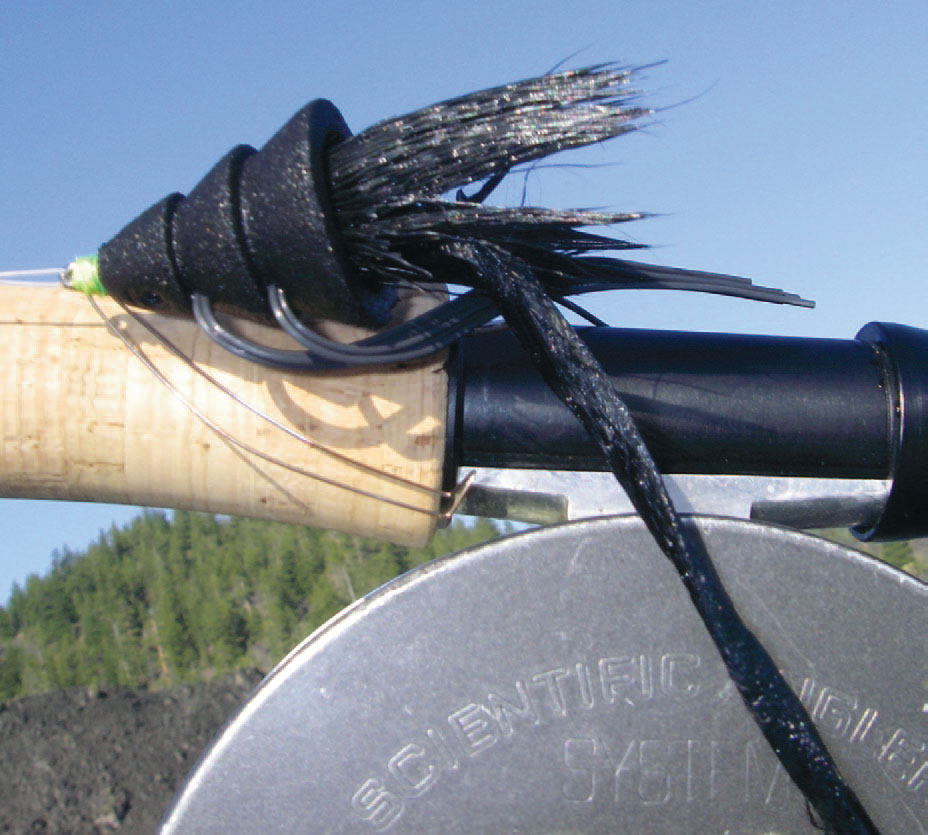
Timing: Postspawn Fish
Postspawn fish are worn out and don’t immediately leave their comfortable inshore areas. An abundance of food and cover will hold them in the area until they move toward deeper water with the arrival of the warmer water temperatures of early summer. If it’s a bright day, they will move out or align close to protection. These fish want to and need to feed, and there is an abundance of food inshore. Minnows, frogs, crawfish, newts, and salamanders are getting larger, and damselflies and dragonflies are increasing in numbers. Fly size can be crucial at this time and should matched to the naturals, if possible. I find that the size of a popper can make or break a day’s fishing, and what works can change during the day. Don’t necessarily go to a different color, just go up or down in size. I like larger poppers, such as a size 2, because they hook better and don’t take the small sunfish, but a drop down the size chain often will induce grabs. My favorite poppers are chartreuse-and-black Sneaky Petes, Jimmy Nix Frogs, and Dahlberg Divers. I also fish large and small crawfish patterns, bunny and squirrel leeches in black, purple, and olive, Gummy Minnows, and the Woolly Buggers I’ve already mentioned.
Be aware of water clarity. Stained water offers protection, and fish will not hold as tight to cover as in high-visibility situations. Bass lie in wait and ambush to feed. They have superbly developed lateral lines to detect food. In stained water, their attack zone is bigger, and they will chase food or a fly for longer distances.
In the postspawn period, you may want to be on the water earlier and stay later. I’ve seen bites shut off by 8:00 or 9:00 A.M. and start after 7:00 P.M. An interesting phenomenon is the well-observed fact that fish all over a lake can react simultaneously, as if a switch had been flipped, and start or stop feeding. My partner and I often split up, with one of us going one way and the other in the opposite direction, and most often, we report the bite starting at the same time and coming from the same kind of structure. Another friend is a conventional-gear angler. We find that both of us take fish during the same periods, though we are using different lures and tackle.
Summer
By the summer, give or take a cold front or two, bass tend to move to deeper water and school up to feed more effectively on forage fish such as threadfin shad. Water temperatures and oxygen concentrations are factors that determine when they do so, but brighter sunlight and increased boat traffic also play huge roles. If I fish for bass with a fly rod in the summer, it’s early and very late in the day, often into the dark. The Delta, with its tides, is an enigma in terms of when the best times to fish occur, but that top-water bite in August is best at first light over submerged wood or berms that have been flooded with a high tide. Another bet is outflows from sunken islands or side channels on a big minus tide. The strong flows tumble crawfish and forage species. Again, the fishing is best in low-light conditions.
I’ve sat on a high bank at Lake Amador and watched a shoreline with binoculars in a deep cove at last light. Like clockwork, a large bass would move up on a submerged ridge and start working off the point and down the shoreline for a hundred or more yards. The fish would swirl on bait four or five times as it patrolled its turf, then disappear again. Trout do this, too. It’s best to sit in a quiet float tube and wait for a bass to move into your range. Don’t cast to the open water. Wait till the fish nears a submerged point, a submerged log, a fence line, or an overhanging bush or tree.
Autumn
Most of my fly-rod bass fishing is in the spring, but Indian summer weather is worth a trip to one of my favorite lakes or ponds. On the larger impoundments, water levels will be drastically reduced, and it can be hard to find the cover that will hold fish. I target the impoundments with constant water levels, whether large or small. I look for the best cover that I can remember and approach with care because of the clear water. Remember Dee Thomas’s words: There’s always someplace where you can find fish.
Open-Water Bass
Bass are adaptive and will feed opportunistically where schools of forage fish are plentiful. If fish have corralled bait and are tearing through the school, it is important to remember that it’s the smaller ones that are on top feeding on the balled-up threadfin shad. The larger bass will hang below and eat the juveniles of their own kind or injured “sinker’s” that can no longer swim well. This is true both out in open water and in a cove where bait is trapped against the shore. Use a weighted fly that is as close as possible in size, color, and texture to the baitfish, and count it down. I knew a conventional-tackle guy who caught an eight-and-a-half-pound bass 200 yards from shore in several hundred feet of water. The bass took a trout that had taken his minnow.
At El Salto in Mexico last November, huge schools of open-water bass in a large, shallow bay were refusing everything. This isn’t supposed to happen on a Mexican lake with El Salto’s reputation. I remembered a friend’s advice (an hour and a half later) and tied a silver-and-yellow Crease Fly to the tip of a shortened fluorocarbon leader on a fast-sinking 7-1/2-inches-persecond line. I broke off two fish and landed two in five casts. Our guide, Pedro, was yelling, “Seis kilos, seis kilos!” — six kilos, twelve and a half pounds! — as the last fish ran like a 25-pound striper toward a submerged tree.
Conventional-gear bass anglers use plastic swim baits that imitate forage fish and even larger lures that imitate planted rainbow trout. Take a walk down the aisle at your big-box outdoor-sports warehouse and look at the realism of the trout swim-baits. Also take a look at the cost of the really good ones! Think big here with your flies.
Going Small, Going Large
Andy Burk wrote an article awhile back in this magazine about “going small” for bass. (See Andy Burk, “Nymph Fishing for Bass,” California Fly Fisher, March/April 2007.) This is certainly true in the smaller ponds and lakes and can be true anywhere. Try a damselfly nymph or a size 10 Pheasant Tail Nymph on a dropper underneath your popper.
I won a tournament at Collins Lake by going small with dragonfly nymphs. I switched to the nymph because I hadn’t caught anything all morning, and I didn’t see anyone else catching fish on poppers, buggers, streamers, or conventional gear on a very clear, bright day. At Almanor, largemouths and smallmouths are part of the catch when the Hex hatch is going on. The Hexagenia limbata is a big mayfly, but small by bass-fly standards. I’ve taken bass on the nymph.
An often overlooked phenomenon on mid-elevation lakes is the carpenter ant migration. Smallmouths can go crazy when the ants are on the water. It is best to use an ant pattern that is bigger than the natural. Small black/brown poppers or foam beetles such as the cicada patterns work fantastically well. I look for the ants at Scotts Flat in late April or early May. The same bugs stir trout and bass higher up the mountain in early summer and again in the fall.
If you feel that you are fishing your poppers or sliders over fish and nothing is happening, downsize and try a smaller size of the same color. Sometimes the fish are afraid of the big bug. There are also times when you want to dare to go big. At night, when you want to move water and make noise, is one of those times. Everybody has heard stories about bass taking ducklings, frogs, and snakes. It does happen, and big flies stir big fish. I fished at central Oregon’s Davis Lake last year with Fred Foisette of Cascade Lake Anglers. The fly that Fred gave me was a six-inch-long black Rainey Tsunami. That fly is scary! It’s designed for pike. My best five fish weighed a total of 26 pounds. I bought the remaining four flies in Fred’s Sun River shop and returned home to try one on a local government pond. The second cast took a three-and-a-half-pounder. Give big flies a decent try and hold on! Quit fishing for the one-and-a-half-pounders!
Stealth
Denny Rickards and other stillwater trout gurus will tell you that stealth and long casts are terribly important for catching big trout in shallow lakes. The same is equally true for bass. If I can target a large fish at 50 feet, rather than 30 feet, my chances of taking that bass triple. Put a mark on your fly line at 40 or 50 feet to help you measure a cast. When angling partner Jim Cramer bonefishes with a new guide, he makes a trial cast so both know what a “60-foot cast” means.
Boat noise, electronics, and any unnatural disturbance puts fish on alert, and your chances of a take drop dramatically. Hard-bodied flies and poppers can land hard and spook fish unless you catch the day they are on an unholy tear. That’s one reason why hair bugs were developed — to land softly.
Fishing from a small watercraft like a pontoon boat, pram, canoe, or, better yet, a float tube gives you a stealth advantage that larger skiffs and bass boats don’t have and never will. Two years ago, I left my rods in my truck and carried cameras with polarizing lens to the shoreline of my favorite lake to photograph spawning bass. I didn’t know that the local angling club was having their annual spring tournament that day, but it proved to be a learning experience. I had scouted the area and knew where many bass were holding. Over and over, tournament boats of all sizes came too close to shore and sent frightened bass scattering into deeper water. Even an electric trolling motor makes noise. And one of the spring favorites of conventional gear anglers is a spinner bait with metal blades and a plastic grub or worm tail — when it was cast inshore, terrorized fish fled the crash of its metal blades.
Gear
You can now buy fly rods designed for bass angling that are shorter than 8 feet, which allows them to conform to the length requirements of bass-angling tournaments. Those rods work great from boats, but from a pontoon boat, float tube, or pram, I like a 9-foot rod. Saltwater fly rods from 6-weights to 10-weights can serve as fabulous bass-bugging rods. The oversized guides shoot line effortlessly when needed, and the heavier butt sections help in bringing larger bass to hand. My favorites are older generation graphite rods that I overline by one weight with aggressive weight-forward bass tapers.
I favor supple 9-foot, 0X leaders that are tuned so that my flies land softly at the end of a cast. In heavy cover, I shorten the leader and use 20-pound fluorocarbon tippets. I tie both to my fly with Loop Knots for better action.
Casts and Retrieves
It is imperative that flies be cast tight to cover. “Tight” means six inches or less, not two feet. Your first cast is the one that will get you the big fish. Don’t screw it up. Each successive cast over the target lowers your odds. Hoard your casts! If nothing is working, move on.
The best retrieve for a popper is to cast tight to your target and let the fly sit until the rings disappear. Minimally twitch the bug several times, let it rest some more, then start a series of longer pulls. Vary with short bursts of three, increasing the speed with each repetition. If you’ve shot your fly to the back corner of a dock, work it out slowly, then increase your retrieve pace as you near the end of the dock. Pause and hit it again. Often a bass will strike at the last possible moment before the food source leaves for open water that the bass doesn’t like. If a wind is blowing, let it take your popper far under the dock.
Bass react to the sound of something hitting a dock, a wall, or the side of a boat. I routinely bounce my poppers or sliders off structure and often cast to shore and hop the bug into water. Old wooden docks seem to hold more fish. Why? They harbor more bugs, lizards, and insects than plastic docks do.
Sometimes bass hit a fly on the fall, even coming out of the water to intercept it. Sometimes they hit a full minute or even longer after the bug lands, or on the first twitch. The take can be a subtle inhalation that you barely notice or a reverberating blast. The best analogy that I have ever heard is that bass bugging is like teasing a cat with a paper ball that is tied to a string. Old cats and big bass are harder to entice, while young cats and juvenile bass are easier. Keep your eyes focused on the bug, because you never know when or how far out a bass will hit. Fishing in colder early season water with leech patterns, buggers, and streamers warrants slow retrieves, but you never know. The moods of bass are many. Try a rip now and then — just because.
Fish bright flies in sunlight, dark flies in low light. Switch to dark and noisy flies at dusk. Tie a floating Crease Fly to a short leader on a fast-sinking line. Do the same with a big Dahlberg Diver. Cast and count down, then pull and pause, pull and pause. Every now and then rip your fly back. Umpqua is coming out with a flyrod pattern called the Pole Dancer this year. It was created and tied by Charlie Bisharat, of Charlie’s Airhead fame. The fly evolved after many tries to imitate the side-to-side motion of a Zara Spook plug. When I was at El Salto, two tournament pros from Florida put two 10s and two 8s on the board the same afternoon. They used Zara Spooks over a flat with submerged trees in a wind chop. Finally we have a bass fly-rod lure that can do the same thing. Charlie thinks big. There’s a “big” and a “bigger” version. I’m waiting for my prototype and will report back.
Identifying and Working a Pattern
Tournament pros start by trying to catch a fish or two so they can identify a pattern in where the fish are holding that day and what works for them at that moment. It may be that the fish are lying 50 feet inside south-facing points. They could be holding near mud banks, rocky slopes, or breaks between the two. Sometimes the place to fish is a mud line downwind from a point or the back of a cove. The pros use high-horsepower bass boats to “run and gun” from one type of cover to the next and work an entire lake that way till the pattern they’ve identified no longer produces. You should do the same in your own way — but work slowly, with extreme stealth. Several years ago, I was a guest of California Fly Fisher contributor Bill Sunderland at a small Wilderness Unlimited lake. Being courteous anglers, we each went in opposite directions and worked in a semicircle for several hours before reuniting at dusk. Both of us had taken 13 bass. All had come on chartreuse poppers from banks that had vegetation down to and into the water. No fish came from mud or gravel slopes. That’s a pattern. When you identify one, milk it for all it’s worth.
Go Fishin’
Bass may well be the most difficult freshwater fish to take consistently on a fly. That’s part of their appeal. You have to do your due diligence, both on and off the water. Two books that I find useful, but that I don’t usually see mentioned when fly fishing for bass is discussed, are reprints of older volumes: James A. Henshall, Book of the Black Bass: Comprising Its Complete Scientific and Life History, Together with a Practical Treatise on Angling and Fly Fishing and a Full Description of Tools, Tackle and Implements (Cincinnati: Robert Clarke, 1881; reproduction edition, Bass Anglers Sportsman Society of America, 1987) and Jason Lucas, Lucas on Bass Fishing (New York: Dodd, Mead, 1947; reprint, Kessinger Publishing, 2005). But the best place to do your homework about fly-rod bass fishing is where it’s most fun — on California’s stillwaters. Go fishin’.



